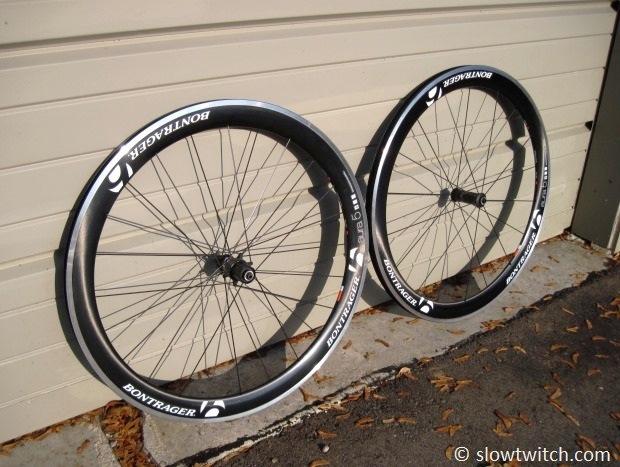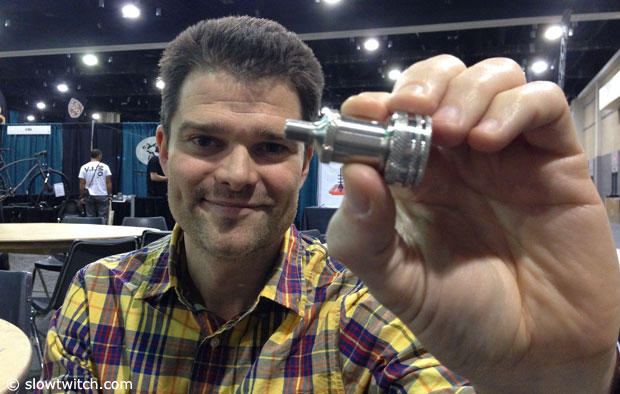Things that roll
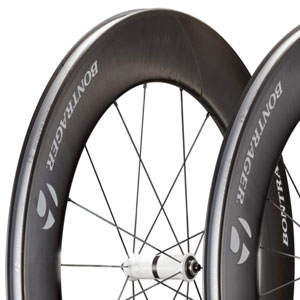
Let's talk about wheels and tires. In fact, let's talk about it all week. It's race wheels I'm writing about and it's about wheel and tire selection, what type of wheel to buy, when to ride the wheels you own, how to prepare them for racing, preparing for a flat, in short, we're going to talk about everything underneath you that rolls or would or might roll during a race. Big subject, so, this'll occur in installments.
The first installment begins with my repentance. I have changed my mind. Completely. I used to believe in training on your training wheels and racing on your race wheels, not putting the race wheels on your bike until a ride or two before the race. I now no longer believe that. Not for triathlon. The reason is this: I'm going to race on the deepest wheels I can, because deeper equals faster. But sticking a deep wheel on the front of the bike on a breezy day is like giving your horse loco weed just before hopping aboard him. The surest way not to get bucked off on race day is knowing how that thing underneath you reacts under all conditions. I therefore ride my tri bike with deep wheels. All the time. I don't care if those who see me think I'm a poser and a dweeb.
This used to be monetarily inconvenient because race wheels were dainty, tender things, and we always had our tubies glued onto them. Nowadays these wheels are tough. The reason they're tough is because wheel companies like HED, Zipp, Enve, Mavic and the rest got tired of selling these carbon wheels only to triathletes. They finally learned how to build a better mousetrap stronger. Now this same basic technology is used in mountain biking, gravel racing and, in probably the hardest test for any wheel, classics racing. When a Zipp 303 can sit underneath a 180-pound rider on an unsprung bike riding over cobbles at 25 miles per hour, and hold together, that technology translated to aero wheels for triathlon means something else is probably going to break before the wheels break. Further, I'm happy riding them with clinchers instead of tubulars. Which means that whole thing just got a lot cheaper.
Ergo, you can ride these race wheels everyday. So I do.
Choosing a wheel for race day
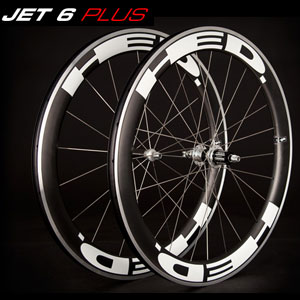
What race wheel should you ride? Half of you have one set of race wheels for all conditions. A third of you have multiple wheels and you choose the wheel based on the day. For all of you, here's how I approach it.
Right now, I have a HED Jet disc, and a Zipp disc, for the rear. I've got a Zipp 808 for the front, a Bontrager Aeolus 9.0, and a HED Jet 60. These are what I'm pedaling around on, and I've also spent quite a bit of time lately on a Bontrager Aeolus 9.0 in the rear as well. I've ridden all these wheels in various configs to figure out just what I'm capable of handling in the most adverse conditions for deep wheels, specifically descents and wind and, most specifically, descents in wind. I don't want to be surprised on race day.
But I also don't want to be caught at a disadvantage through being out-featured on the race course. Let's talk about that Bontrager Aeolus 9.0. This is a very fast wheel. I know this because I've ridden these wheel combos over a couple of timed courses I use for comparison sake — my cheap man's wind tunnel — and when I ride this wheel on the front of the bike I ride faster than my fitness warrants. This is just a fast, fast wheel. But its interesting shape — it's just a big elipse — creates idiosyncratic handling, in my experience. This wheel has a behavior.
To understand this behavior, you have to realize what's going on when you're riding a bike in a straight line. You can't ride that straight line. You'll eventually veer, and let's say you veer to the left. Your center of gravity is to the left of the line you want to hold. You have to steer back to the preferred line, but before you can do this you have to get your CG in between the line you're riding — described by a line through the front and rear contact patches of your tires — and the line you want to reacquire. So, if you're veering left, before you can veer right you have to first veer even more to the left. This isn't anything you need to think about. It's second nature. You're doing it already. I point this out because, even in very light winds, once you veer to the left, get your CG between you and the line you want to ride, you're going to steer back to the right through leaning. When you're in the aero position the agency or fulcrum of the turn is at or around the point of your shoulder, or at least so it seems and feels to me.
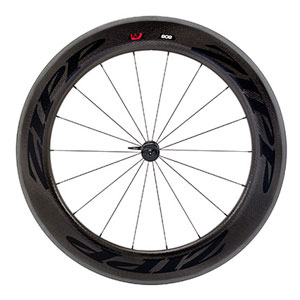
So, you veered left without wanting to do so, you then veer more left to get your CG on the right hand side of your bike's line, then you veer right to reacquire the line you've lost, but when you lean right the front half of your front wheel — that part of the wheel in front of your steering axis — is exposed on its right hand side to the oncoming wind. This, even in a completely still wind. What I feel with this Bontrager Aeolus 9.0, whenever even a puff of extra wind hits this wheel from right to left, is the wheel getting hung up in the wind, like a sailboat in a broad reach. And in fact that's what it is. I'm sailing. That's one reason this goldarned wheel is so fast. The wheel is stuck, right there, like a sail in the wind, as I'm leaning to the right… tipping over. Which is a little unnerving the first several dozen times it happens. But in fact the more I lean, the more pressure I put on the wheel to turn, and that pressure eventually overcomes the force of the wind holding the wheel in place, and I turn.
Pardon the long explanation, but, I do not feel this with a Zipp 808, which is almost as deep as that 90mm Aeolus. The Zipp has a different shape. The Zipp has its own handling personality and I can't say yet whether I like or dislike this wheel in a wind more or less than the Aeolus 9.0. I have come to terms with both front wheels. What I can tell you is this: I'll ride at least an 80mm wheel, if not a 90mm, every place I can, every time I can. These wheels are just flat out fast.
Center of Pressure
What can I do to make it so that I do and can ride these very deep wheels more often? What you'll hear some people say is that you should ride a very deep wheel in the rear. A disc if possible. This, to move the "center of pressure" rearward, stabilizing the front of the bike. I have tried this. I don't think it works. The reasoning might be sound; I just don't think it works. I don't sense, when I ride these various combinations, that the bike is a single pressurized construct. What I sense is that the steering axis creates its own discrete construct, and the only way to counteract the pressure applied to the bike in front of the steering axis is to normalize the pressure behind the steering axis but attached to this construct rotating around the steering axis. For example, imagine a fly swatter with the handle attached to the front dropout, and the swatter part sticking directly rearward. The larger the swatter, and the longer the lever — the further the swatter sits behind the steering axis — the more pressure the wind exerts to the construct behind the steering axis, counterbalancing the pressure on the front. The idea is that the wind hitting the front of the wheel pushes it one way, the wind hitting the swatter, combined with the wind hitting the part of the wheel behind the steering axis, pushes the wheel in the other direction, creating neutralizing forces. Theoretically.
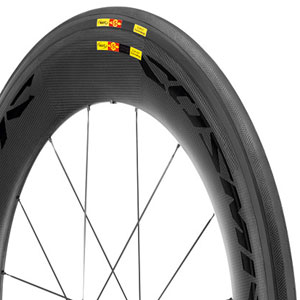
Realize that everything in front of the steering axis — superbike nosecones and front brake fairings, for example — adds to this pressure on the front of the bike when the wind hits it. These new superbikes are more aero but in my opinion create some interesting handling behaviors. Anyway, the point is, no, putting a disc on the back of the bike does not, in my experience, change the handling behavior on the front of the bike. If forks are reengineered, so that the surface area of the blade sits behind the steering axis or at least not so far in front of it, maybe this will make a difference. The problem is, nobody is measuring the torque on the fixture holding up the front wheel when a bike is yawed in the wind tunnel. If they did, they'd see more about how their bikes handle, rather than just seeing whether or not they're aerodynamic.
Gearing viewed as a steering input
Where I feel the most helpless and at the mercy of the wheels and the wind is on a descent, and when I'm not pedaling. When I'm applying force to the bike through pedaling, that's a steering input. When I am forced to coast, I lose that input. Therefore, if I'm going to ride a deep front wheel on a course with descents, I try to make sure I've got a big enough gear on the bike to pedal any descent where I hope to remain in the aero position. Even if I'm only pedaling very lightly, and not making the bike go any faster, I just like the steering input. So I've got 110mm bolt pattern cranks on my tri bikes, but I also keep 53×39 chainrings around in that 110mm bolt pattern in case I need them. I'll ride the 50×34 when I can, because I need the small gear more than I need the big gear on a course with steep inclines, and because I'll have a tighter range of usable gears if 50 teeth is my largest gear and I can ride a 23t or 25t as my smallest gear. But that 53t can help on high-pucker descents.
I don't like to have to bail out of the aero position. I never want to have to do this. But if I do, I'd like not to die. The pursuit position matters to me in this case. So, let's talk specifics. I've got 2 bikes set up right now for triathlon, and I'll be writing about these bikes in the near future — why I have each bike set up each way. One is that reconceived (in 2013) Speed Concept. The other is a Felt DA. I think the Speed Concept is the faster bike. But the DA is a more predictable bike when I'm bailed out on the pursuits on a descent. This is because the DA allows me to choose my pursuit bar, and the tilt of this bar, and exactly where I want it represented in space. The 9-Series Speed Concept offers fewer options. I don't like the Speed Concept's pursuit position. But, the bike is aero as heck.
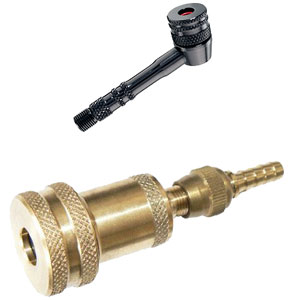
So, I'll choose the Speed Concept unless it's windy and the course has descents and then I'll err on the side of the DA because it's a better handler while in the pursuit position. If it's a really twisty course when I'm spending a lot of time in the pursuits, I might choose the DA. If I'm racing Ironman France or the Santa Barbara Triathlon I'll probably choose the DA, because I'm in the pursuits so much of the time. Ironman Arizona, Texas, Florida? The Speed Concept.
I can stick any wheel on the back of the bike and it doesn't bother me. I've ridden discs in big winds, no problem. As far as I know, you can ride a disc wheel in any Ironman race other than in Kona and in Cozumel. You'd better check before you just show up with a disc. Handling-wise, the issue is the front. I can also ride 60mm deep wheels on the front without much problem. That 60mm HED Jet is my fallback wheel when I just don't feel I can confidently ride an 80mm or 90mm front. Yes, this might mean taking 3 wheels to the race with you — a rear and a pair of fronts depending on the conditions and the situation.
Here's the thing: whatever you do, make sure you've spent a lot of time on your race wheels, so that you know how they'll handle. You don't want to be surprised on race day, and I don't want to be riding anywhere around you if you're surprised on race day.
In future installments we'll talk about how you plan to not have a flat, and what you need to do to minimize the pain if you get a flat. Pursuant to that, we published an interview today with Josh Poertner from Silca. You might want to read that over, as this company is going to become a more and more important part of your life, I predict. Specifically, the very simple but brilliant idea of taking Silca's fabulous presta valve floor pump adapter, and it's nice disc adapater — aka crack pipe — and threading each instead of just affixing a barbed end to each means you have to heads and one pump, rather than having to schlep two floor pumps to the race, or shoving the barbed end of the crack pipe into your presta adapater thusly shortening the life of the latter.


